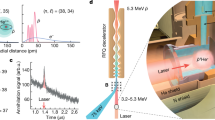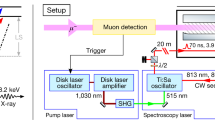Abstract
THE ultra-violet spectrum of neon consists of the lines belonging to the principal series of the arc spectrum and the lines of singly and doubly ionised neon. To obtain the Stark effect for these lines it is essential to increase the field strength for the lower members and the intensity for the higher members. The spectrograph used was the Steinheil Q.D. type. The field stength was determined from helium lines.
This is a preview of subscription content, access via your institution
Access options
Subscribe to this journal
Receive 51 print issues and online access
$199.00 per year
only $3.90 per issue
Buy this article
- Purchase on SpringerLink
- Instant access to full article PDF
Prices may be subject to local taxes which are calculated during checkout
Similar content being viewed by others
References
L. Bloch, E. Bloch, and G. Déjardin : Comptes rendus, vol. 180, No. 10, p. 131; 1925.
T. L. de Bruin : Zeit. f. Phys., vol. 46, p. 856; 1928.
Author information
Authors and Affiliations
Rights and permissions
About this article
Cite this article
ISHIDA, Y. Stark Effect in the Ultra-violet Spectrum of Neon. Nature 125, 970 (1930). https://doi.org/10.1038/125970a0
Issue Date:
DOI: https://doi.org/10.1038/125970a0



